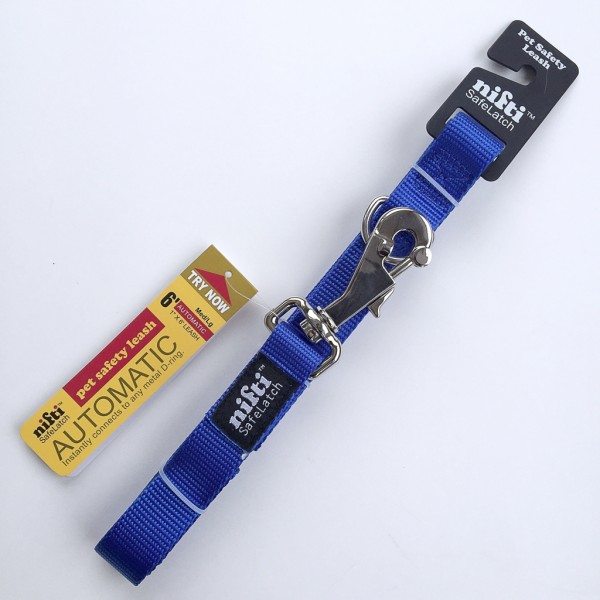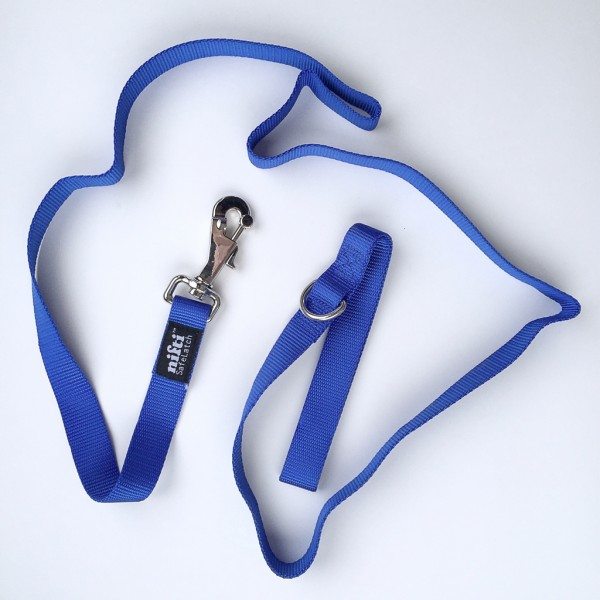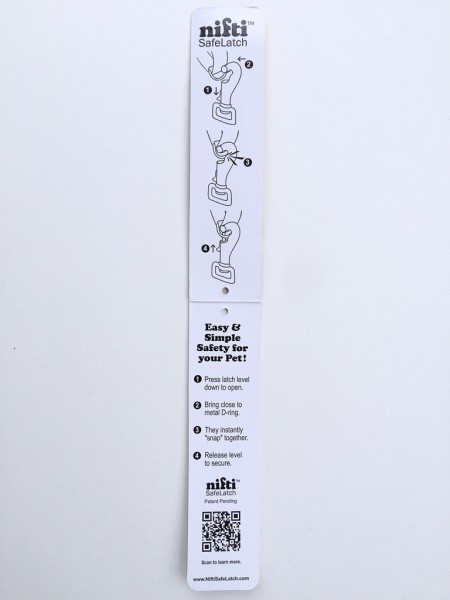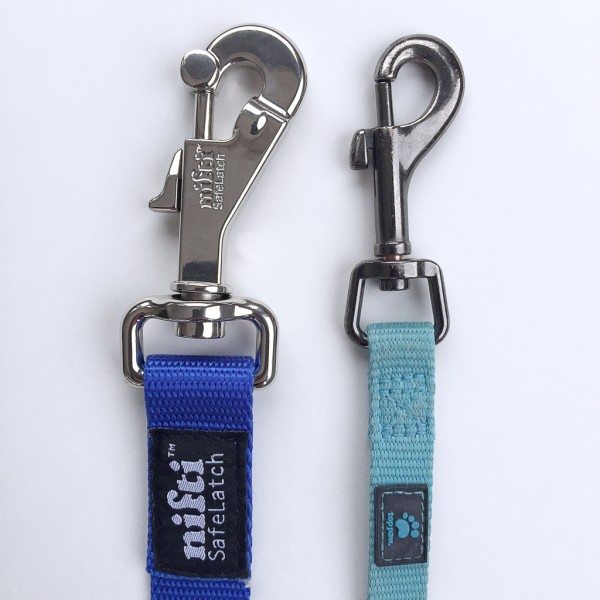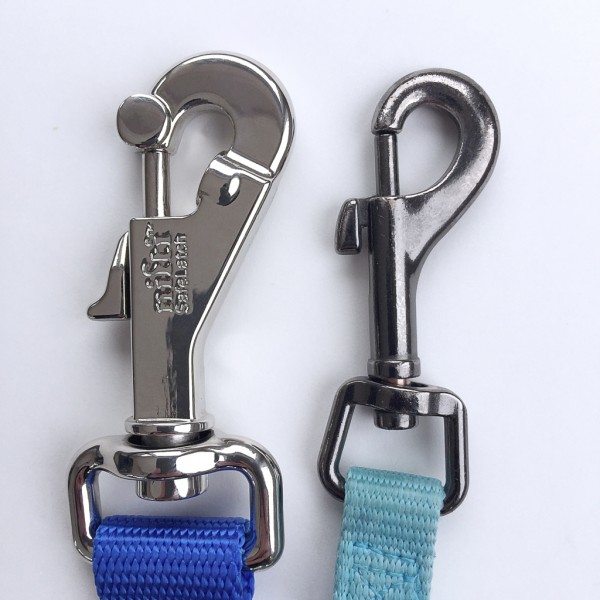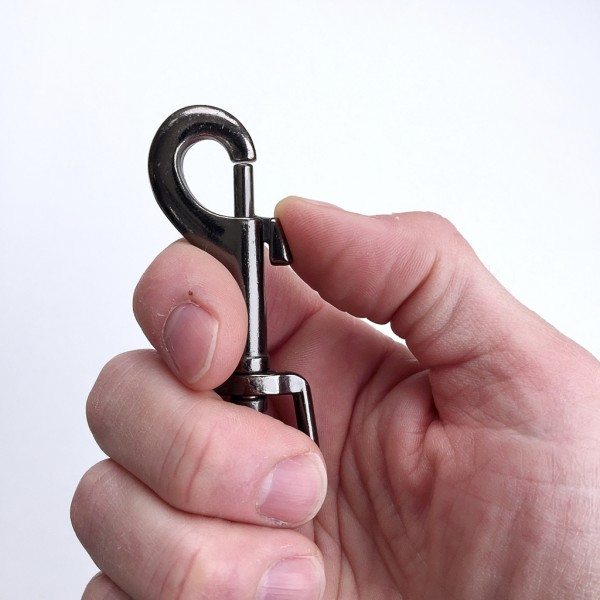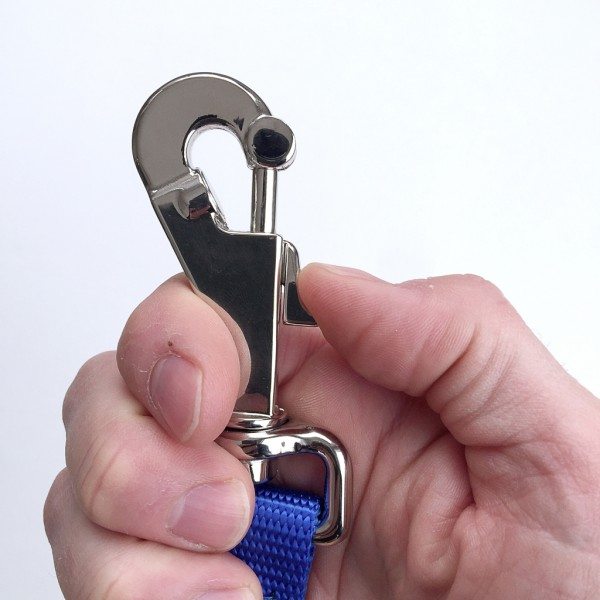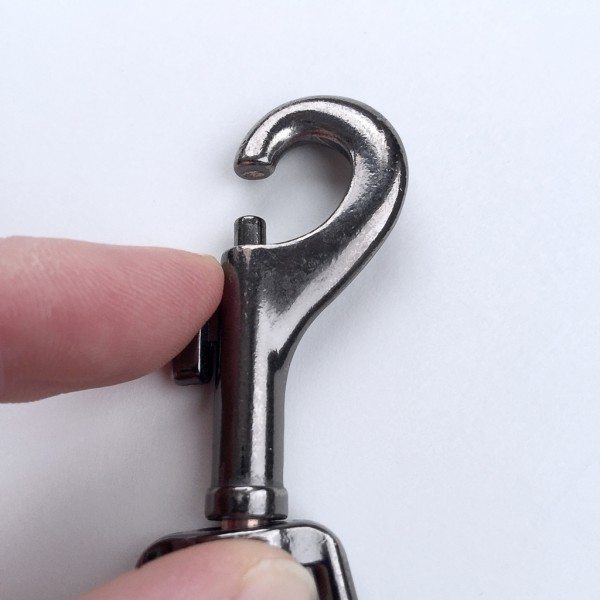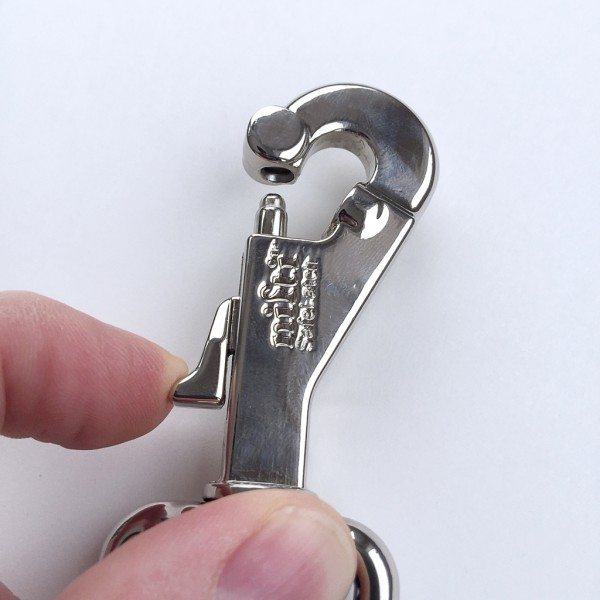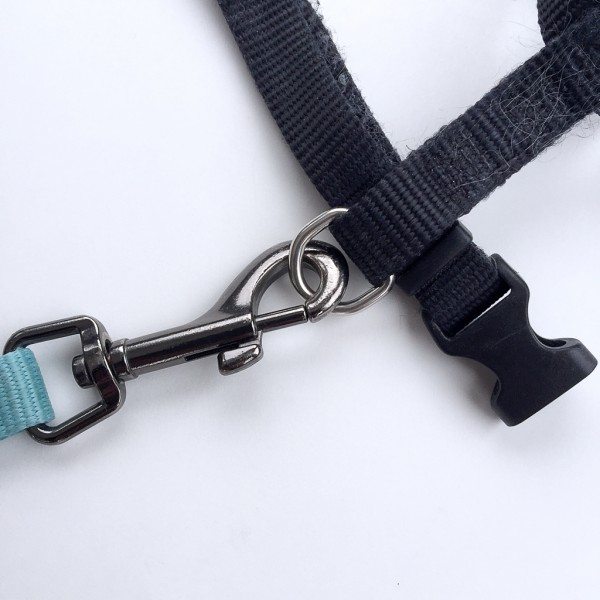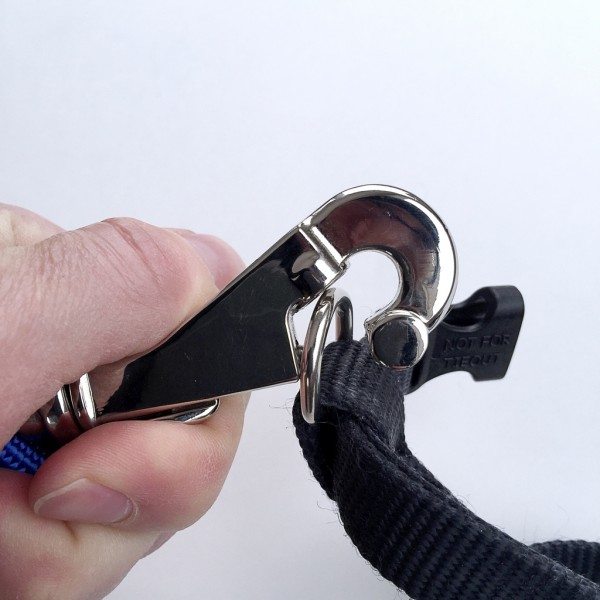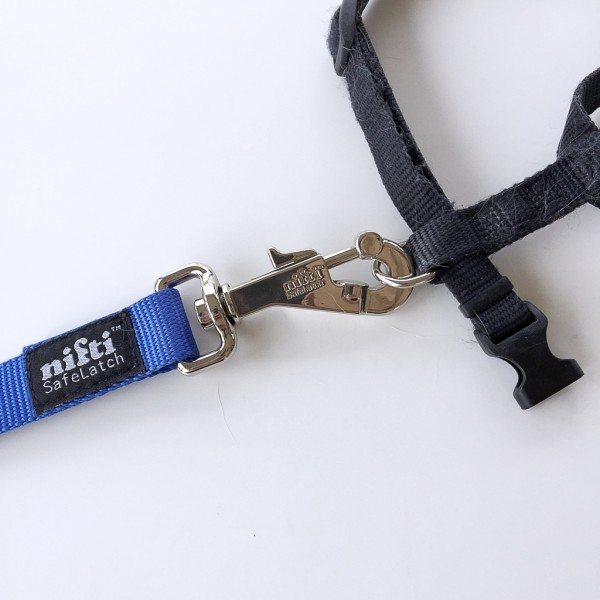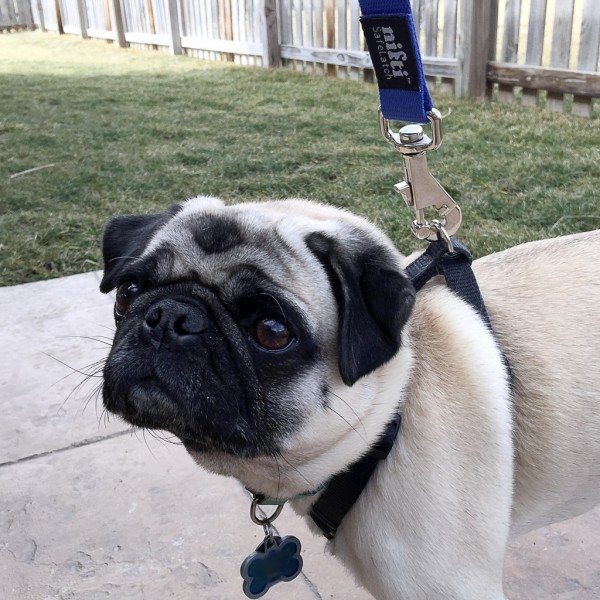Do you have one of those dogs that seems to be able to Houdini its way off its leash? Well, I do. And that’s him, pictured above. Boba the Escape Artist. Oh, he looks innocent enough, but he’s clever, fast and ornery. He’s also somehow managed to unlatch his leash from his harness quite a few times while out for walks. So when Julie offered the opportunity to try out the Nifti SafeLatch pet safety leash, I thought ol’ Boba might be a good test subject. Let’s see how the Nifti SafeLatch fared. Gadget on!
Specs
- Neodymium rare earth magnet
- Pull-tested to 660 pounds
- Patented design (Nifti calls it “The First major change to the bolt snap latch since 1881.”
- 6 foot length x 1 inch wide webbing
Options
Nifti SafeLatch is available in:
- (1) size = Medium/Large
- (5) colors = black, red, royal blue, neon pink and neon orange.
Packaging
Packaging was simple: a hook to hang the product and a tag.
Features & Functions
At first glance, the Nifti SafeLatch appears to be standard dog leash. But it does include a few features that make it potentially more useful than a standard leash. The main one is of course the latch, and I’ll get into detail on this below. Another is a metal D-ring that is stitched into the strap just below the handle loop. This D-ring is a handy feature for hanging things like keys, a flashlight or one of those little pods that hold dog-pooh bags all within quick reach.
Opening the tag on the Nifti SafeLatch reveals the instructions, which are simple enough to be depicted with just three steps. Easy peasy.
As seen in the image above, I compared the Nifti SafeLatch on the left with Boba’s current leash on the right in the image above.
Above, a closeup of the latch mechanism of the Nifti SafeLatch (left) and a standard latch mechanism (right). Because, well…I like closeups. The very first thing I noticed about the Nifti SafeLatch’s latch mechanism is that it is a heavy-duty piece of metal. Not some cheap, cold-cast, semi-metallic alloy, but a thick, burly polished stainless steel brute. Rock on.
Boba’s current leash has a fairly standard latch, as shown above. It operates simply by pulling back on a slider with your thumb to open it.
The Nifti SafeLatch operates in an identical fashion. One subtle difference that the thumb slider, which the Nifti folks call the “thumb shape level,” is a bit longer and more boldly shaped than the standard slider. It does feel a bit easier to slide open, and because of the shape, which protrudes a bit further away from the latch, it keeps your fingers out of the latch opening area.
Another subtle, yet, I think important difference between the standard latch and the Nifti SafeLatch is with the latch closure. Looking at the image above, you can see that the slider pin is flat, as is the side of the latch that it contacts when it is completely closed. However, the Nifti SafeLatch is a bit different design, as shown below.
In the image above, the Nifti SafeLatch can be seen in detail. Note three things. First, the thumb slider’s shape can be seen. Second, and I think more importantly, the slider pin’s tip has a small protrusion that is of a slightly smaller diameter than the rest of the pin. This tip diameter has been matched to the mate with a small hole on the opposite side of the closure. The smaller-diameter tip fits into the hole when the Nifti SafeLatch is closed. This may not seem like much, but I see this as an added level of security to help keep that latch mechanism closed while using it with your dog. Third, the Nifti SafeLatch’s Neodymium magnet can be seen. It is located on a bump on the right side of the latch where the latch angles upward. More on this later.
In the image above, I’ve attached the standard latch to the metal D-ring on Boba’s harness. Pretty standard.
The Nifti SafeLatch, as seen above, is a bit different. I’ve slide back the slider to open the latch, and the Neodymium magnet has “grabbed” the D-ring on the harness. The magnet automatically helps guide the harness’s D-ring right into the position that it needs to be for the latch to close.
Once the Nifti SafeLatch has been closed, it appears to function like any other leash latch, but with those few added security features detailed above, I am expecting a more secure connection.
How did the Nifti SafeLatch work? We took Boba on several walks with the Nifti Safelatch for a live action test. It performed quite well. The latch was easy to connect due to the magnetic attraction of Boba’s harness D-ring right into the latch, and he did not once manage to get the latch open—and I think this is due to that little extra tip on the latch slider that fits into its mating hole. To be fair, I don’t know for sure if it was the Nifti SafeLatch, or if Boba just wasn’t in an escape-artist mood on our recent walks. I suppose that at minimum, the little guy didn’t get out, so that was a success. As you can see above from Boba’s expession, he may not have been as happy I was that the Nifti SafeLatch worked as well as it did. Sorry, buddy.
Conclusion
The Nifti SafeLatch pet safety leash is not only heavy-duty in terms of construction, it also has a few extra features that set it apart from other leashes. Its Neodymium magnet built helps pull the metal D-ring on a collar or harness right inside the latch, while an extra little tip on the latch slider gives the latch an added layer of security that helps keep the latch closed. Also, the latch’s thumb slider is shaped in such a way as to allow it to be operated easier than a standard leach latch. The only downside I see is that they need to offer one in a slightly smaller size for pugs. 🙂
06/28/16
The Nifti SafeLatch is a very well constructed leash. I still use it all the time for my “escape artist” pug and he has not defeated the latch mechanism yet. I do still wish it was available in a smaller size for smaller dogs.
Source: The product sample for this review was provided by Nifti Safe Latch. For more information, please visit their site.
Gerber Gear 22-47162N Fast Draw Folding Assisted Opening Pocket Knife, Fine Edge, Black
$42.73 (as of December 15, 2025 18:09 GMT -05:00 - More infoProduct prices and availability are accurate as of the date/time indicated and are subject to change. Any price and availability information displayed on [relevant Amazon Site(s), as applicable] at the time of purchase will apply to the purchase of this product.)Gerber Gear EVO Jr. Folding Knife - Serrated Edge [22-41493]
$28.99 (as of December 15, 2025 18:05 GMT -05:00 - More infoProduct prices and availability are accurate as of the date/time indicated and are subject to change. Any price and availability information displayed on [relevant Amazon Site(s), as applicable] at the time of purchase will apply to the purchase of this product.)Product Information
| Price: | $27.00 |
| Manufacturer: | Nifti Safe Latch |
| Requirements: |
|
| Pros: |
|
| Cons: |
|


